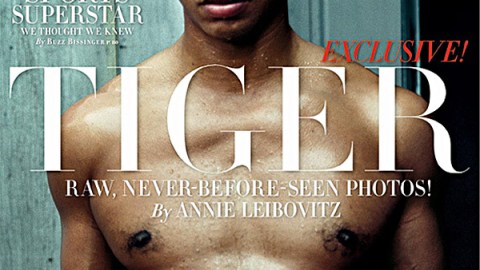Unforgivable Blackness

Enough time and thought has been spent on the philandering of Tiger Woods, so I don’t want to follow the crowd. From my visual perspective, the most interesting part of this soap opera is the transformation of an extremely likeable, vastly marketable American of color into a sexually charged punch line. Annie Liebovitz’s photo of a shirtless Tiger pumping iron on the February 2010 cover of Vanity Fair was taken before the recent revelations, but in its repurposing I find themes that go back centuries.
When Liebovitz took the photo, I’m guessing that Tiger wanted to recreate himself as the boy wonder all grown up. Like the personas of teenage pop idols as they grow older, Tiger’s persona as the clean-cut, one-man United Colors of Benetton no longer suited him as a family man. I imagine he wanted some of the “sexy, yet safe” type of endorsements that football’s aging boy wonder, Tom Brady, has been scoring. A shirtless picture with bulging muscles and smoldering stare seemed the ticket to a whole new marketing sphere. Unfortunately, a dozen or so mistresses later, that plan is no longer operative.
Even before you open the issue and read the accompanying article, Buzz Bissinger’s “Tiger in the Rough,” you suspect that it won’t end well for our (fallen) hero. Bissinger rakes Woods over the coals, but the cover photo itself seals the deal on the death of Tiger the mainstream multicultural hero. Black—from his skin to the cap on his head to the weights in his hands—is all you see. I almost thought that someone had manipulated the contrast, as TIME Magazine had done to the mug shot of O.J. Simpson when that long national nightmare began. Simpson, too, fought hard to be the “acceptable” black man in American media before his downfall. But the “unforgivable blackness,” to borrow a phrase from Ken Burns’ documentary on boxer Jack Johnson, falls on Woods as it once had on Simpson and Johnson thanks to the one “sin” that links all three—sex with white women.
The primordial myth of Southern antebellum culture is the purity and honor of the white Southern lady, which must be protected from its antithesis—the unbridled sexual power of the black male. Anyone who’s watched D.W. Griffith’s The Birth of a Nation easily recalls the unwelcomed advances of the black-faced white actors towards the innocent belles, which only the “heroic” Ku Klux Klan could thwart. It’s a sad, but true fact that traces of that mindset linger in the consciousness of the American people. Seeing Woods pump iron and uncharacteristically display the physique he usually keeps hidden under Nike-logoed clothing, the comparison to Johnson leapt out at me almost immediately. All traces of Woods Asian heritage seemed lost. He was black, and nothing else, at least in that photograph.
African-American artist Barkley L. Hendricks, subject of a recent exhibition at the Pennsylvania Academy of the Fine Arts titled “Birth of the Cool,” poked fun as this portrayal of black male sexuality in a 1977 self-portrait titled Brilliantly Endowed. Nude except for some jewelry, striped socks, Converse sneakers, and an applejack cap perched on his head, Hendricks faces full frontally the long history of racist portrayals of African-American men and laughs in its face. It’s harder to look at the cover photo of Woods and laugh. There are plenty of reasons to not think highly of Tiger right now, but race shouldn’t factor into any of them.
I’m not condoning how Woods conducted his private life, which will always be between him and his family. I’m not even accusing Vanity Fair of nefarious motives in their cover selection. What I am saying is that images such as the February cover tap into the visual cultural storehouse of America and cast up old prejudices in ways that can circumvent more enlightened positions. Racial dialogue fails in America because of all that remains unsaid. Tiger’s cover photo draws directly from that silence and speaks to us in a language of misunderstanding and intolerance. We may find ourselves waiting for Woods to ask forgiveness, but the final truth, in this case at least, may be that he’s the one owed forgiveness after all.




